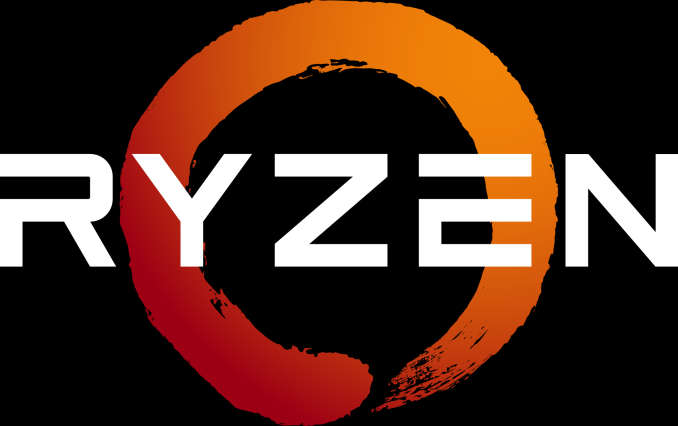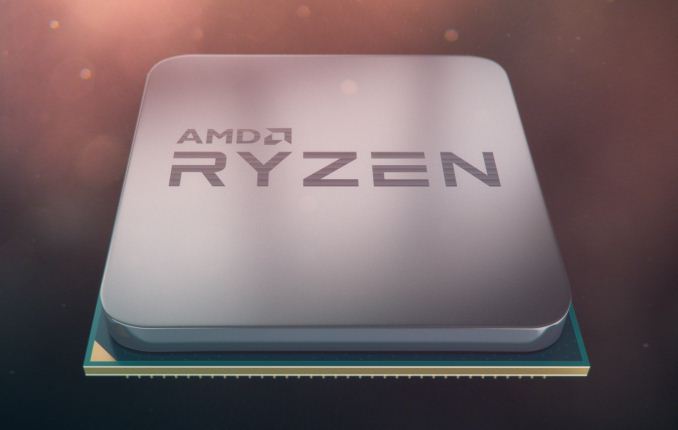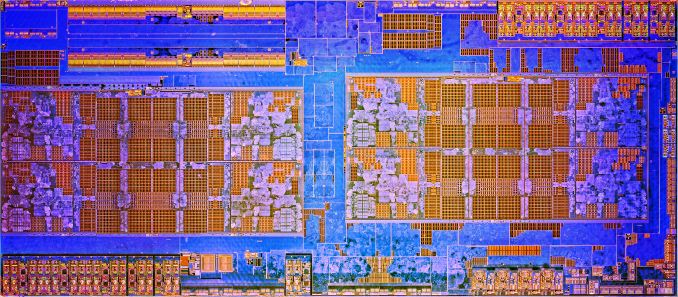AMD Launches Ryzen: 52% More IPC, Eight Cores for Under $330, Pre-order Today, On Sale March 2nd
by Ian Cutress on February 22, 2017 9:00 AM EST
The biggest x86 launch for AMD in five years is today: Ryzen is here. As always before a major launch, AMD gives a ‘Tech Day’ for relevant press and analysts, and through this event AMD’s CEO, Dr. Lisa Su lifted the lid on one of the most anticipated products in the semiconductor industry. AMD knows how to control the level of enthusiasm for its fans, and today is the end result, with processors going on pre-order from major retailers today at 1pm EST, ready for a general hard launch on March 2nd.
In a similar vein to launches of recent smartphones, AMD is doing a staggered announcement/launch with the products on their new microarchitecture. Where Samsung/Apple might give all the details for a product a few weeks before it’s available to buy, today on February 22nd marks the day where AMD is giving consumers information about Ryzen, and specifically the Ryzen 7 family of eight-core products. All the information today is from AMD, and AMD’s internal testing, and pre-orders also start from today for users ready to put down their money for a launch day part. Reviews of the CPUs, as well as when the CPUs will ship to customers, is on March 2nd. This also happens to be right in the middle of two annual shows, Game Developer Conference (GDC) and Mobile World Congress (MWC), making the time between receiving pre-launch samples and being able to provide independent verification of AMD’s performance claims relatively frantic. We’ll do our best!
The Ryzen Family
With a new processor launch, naming the parts and positioning them within the market is critical. So with Ryzen, the processor stack will be split into three based on performance and price: Ryzen 7 at the high end, Ryzen 5 in the middle, and Ryzen 3 for more price-conscious consumers. Both Ryzen 5 and Ryzen 3 are set to be launched later, and Ryzen 7 is the first portion of the family to be released.
Ryzen 7 will have three CPUs to start, all having eight cores and supporting simultaneous multi-threading:
- Ryzen 7 1800X: 8C/16T, 3.6 GHz base, 4.0 GHz turbo, 95W, $499
- Ryzen 7 1700X: 8C/16T, 3.4 GHz base, 3.8 GHz turbo, 95W, $399
- Ryzen 7 1700: 8C/16T, 3.0 GHz base, 3.7 GHz turbo, $329
Ryzen 7 1800X will be the high-end part, featuring a base clock of 3.6 GHz and a turbo of 4.0 GHz, within a TDP of 95W, and for $499. Next to this is Ryzen 7 1700X, launching at $399, with a base/turbo of 3.4/3.8 GHz. The final part for the launch is the Ryzen 7 1700, providing eight cores and sixteen threads for $329 at 3.0/3.7 GHz frequencies.
Processors will initially be available for pre-order from 185 retailers and OEMs worldwide, either as individual parts or pre-built systems.
What, not 40% IPC? 52% IPC??
Enthusiasts and analysts use the term IPC, or ‘Instructions Per Clock’, as a measure of how much the underlying microarchitecture improves from generation to generation. Two decades ago, a good design on a smaller node could net a healthy double-digit gain, whereas in recent years 5-10% gain has become the norm. When AMD initially announced that the new Zen microarchitecture they were developing was aiming for a 40% IPC gain, despite the low IPC they were starting from, users remained skeptical. AMD rehired Jim Keller to work alongside long-term AMD architect Mike Clark and produce a team with several goals in mind: high-performance x86, simultaneous multithreading, and a product to be relevant in the computing, PC, server and mobile space again. So despite this, 40% IPC always seemed a somewhat lofty goal, because Bulldozer was so underwhelming, and despite this low starting point. For the Ryzen launch today, AMD is stating that the final result of that goal is a 52% gain in IPC.
This is something we will need to test in due course!
The Ryzen Silicon, and the Future
AMD pointed out that the new 8-core silicon design runs 4.8 billion transistors and features 200m of wiring. Through previous announcements we’ve examined parts of the microarchitecture including cache sizes, threading, front-end/back-end design, and so on.
AMD Zen Microarchiture Part 2: Extracting Instruction-Level Parallelism
AMD Gives More Zen Details: Ryzen, 3.4 GHz+, NVMe, Neural Net Prediction, & 25 MHz Boost Steps
AMD’s CEO was keen to point out that this is a from-scratch design for AMD, using the knowledge gained from features developed for previous products but ultimately under the hood it looks like ‘a typical x86 high-performance core’, with AMD-specific features and tweaks. We were told that AMD’s roadmap extends into the multi-year range, so while the focus for 2017 will be on this family of products, back at HQ the next two generations are in various stages of development.
BENCHMARKS PLEASE
So despite the 82+ motherboards going to be available, 19 initial PC system builders moving into 200+ through the first half of 2017, the big question on everyone’s lips is how exactly does it perform?
Well, AMD gave us the following numbers:
AMD's benchmarks showed that the top Ryzen 7 1800X, compared to the 8-core Intel Core i7-6900K, both at out-of-the-box frequencies, gives an identical score on the single threaded test and a +9% in the multi-threaded test. AMD put this down to the way their multi-threading works over the Intel design. Also, the fact that the 1800X is half of the price of the i7-6900K.
In a similar vein, again with the Cinebench 15 multi-threaded test, the Ryzen 7 1700X scores over and above the Core i7-6800K (its price competition) and higher than the Core i7-6900K which costs 2.5 times as much.
We’ll tell you what our benchmarks say, with official retail processors. But you will have to wait until March 2nd. Sorry.





















386 Comments
View All Comments
drothgery - Wednesday, February 22, 2017 - link
You do know that process names have been pure marketing rather than measuring feature sizes for a while now, and Intel's "14nm" is roughly comparable to anyone else's "10nm", right?Morawka - Friday, February 24, 2017 - link
I haven't seen anyone beat intel's Density and Metal interconnect.. even GloFound 7nm has a 20nm metal interconnect.Meteor2 - Sunday, February 26, 2017 - link
Morawka, I don't believe that's the case; GloFo have said that they are skipping 10 nm to concentrate on making 7 nm a full node, which should be comparable to Intel's effort. It's TSMC who are planning to use much larger back end of line, pushing up their effective transistor density.BrokenCrayons - Wednesday, February 22, 2017 - link
It's certainly okay to disagree with someone, but is f-bombing really necessary to get your point across? I don't think it makes your thoughts seem more valuable to get so ...um... "NASCAR" about things.damianrobertjones - Wednesday, February 22, 2017 - link
What a horrible person you must be to post such a horrible thing.P.s. Of course Intel has been holding back. They're in it to make money to speed us along into the next great thing.
shaolin95 - Wednesday, February 22, 2017 - link
Dont mind that III-V moron..... I am happy to see AMD finally step back into the game. Intel will need to bring better prices and finally show the real advanced they have been holding back since there was no competition. The CPU market has been VERY boring but now there is finally excitement in the air.Let the games begin!!!!!
ddriver - Wednesday, February 22, 2017 - link
They have been holding back so obviously that only an "uneducated fuckwit" would fail to notice it.Intel999 - Thursday, February 23, 2017 - link
They better have been holding back. They just got their arse kicked by a company that is still, essentially a node behind.Their rollout of 14nm has been their most problematic rollout ever.
It is obvious that Intel's massive R&D spend has been heavily tilted towards trying to stay ahead in the node race instead of investing in any material architecture improvements.
Until they spin off the fabs and start putting real effort and money into architecture they are going to remain in a world of hurt. At this point, the evidence suggests that the only way they can beat Ryzen is with higher frequencies (7700K). Then again we haven't officially been introduced to AMD's 4 core CPUs. If they have one in the wings that runs at 4.0 ghz their superior IPC makes the 7700K an also ran.
More food for thought is the fact that in the back half of the year AMD will have seasoned yields on 14nm that will allow for modest bumps in frequencies from where they are now.
Intel's is going to lose margin and sales this year and they did not guide for that in their recent 2017 financial guidance. When the blind loyalist see this there will be a freefall in Intel's share price.
They are called "puts". All of us should be buying them.
Sometime after the Q2 earnings release is when all of this "should" become apparent to the Intel investor base.
eddiechi - Friday, February 24, 2017 - link
Holding back?Here is one "uneducated fuckwit" that failed to notice it, but noticed a number of other things that lay contrary to that edict....
Intel's brand cache has been eroding for years now, the erosion was accelerated when CEO Krzanich took reign and has forever proclaimed success on Moore's Law..... Things have deteriorated severely at Intel.......
Intel's brand cache has been eroding for years now, the erosion was accelerated when CEO Krzanich took reign and has forever proclaimed success on Moore's Law.....
Things have deteriorated severely at Intel. Internal sources at Intel have stated the climate has been awful and not just due to recent layoffs of 12,000 or 11% of workforce. In light of many recent news headlines and not just Ryzen, Intel is probably in the most delicate situation it has ever had to face.
CEO Brian Krzanich has lead Intel into a slow death spiral and it hurts me to admonish my croation brotheren. Back in 2006 Intel had about a 50% market share with AMD and has watched it increase dramatically every year since to now about 80/20 but years of bad decisions and throwing good money after bad have caught up to the CEO with his pants down. Throwing $8 Billion at Mcafee and $17 Billion at Altera and wasted Billions trying to crack the mobile market with the “contra-revenue” Bay Trail processor where Intel basically tried to bribe tablet makers into using Bay Trail Processors at substantial loss for Intel.
All these casualties has had the CEO reducing costs at the greater cost of unexpected consequences. The delay on 10nm has just increased, worse yet Canon Lake is not expected to feature any significant architectural improvements…. The CEO mistakenly doubled down on the hope that AMD not competing with them - so those that think “Intel has been holding back” are severely mistaken, there is the rumbling of a major earthquake going on right now under Intel’s feet……. Management has been coalescing to get momentum to push CEO out and bring in Murthy Renduchintala. Krzanich has lead a disaster and has basically and systematically undressed Intel, R&D is screwed and has left a void until well into 2019, CEO had completely underestimated the possibility of an AMD comeback while trying to continue with his Moore’s Law mantra which has been basically tossed out window with end of tick/tock procedures followed for almost a decade.
CEO has sat by idly after their 2016 Q4 earnings call from CFO stated product issues have limited profitability mainly due to fault with Atom c2000 family that bricks devices and had to set aside a pot of cash to deal with problems and recently announced Atom C2000 chip line contains a clock flaw and the recently hired COO Kim Stevenson resigned after just taking helm of division that leads PC business in August.
Intel has been in no position to “hold back” recently with all the internal problems and now AMD has just put them way behind the 8-ball. Should expect a plethora of changes at Intel shortly after Ryzen is released, writing has been on wall way before recent revelations of potential AMD comeback….. adding to issues of AMD resurgence is that Intel is also in the crosshairs of sleeping giant Qualcomm.
Kaby Lake brought in “new” PAO process, Process - Architecture – Optimization….. there is no underlying change to the microarchitecture, Intel is not promoting any performance difference with the previous generation, they are however promoting better efficiency and creating a bit more headroom for OC’ing. Moore’s Law has driven Intel computing for a decade and has now forced Intel to dump tick/tock at most inopportune time with CEO not seeing AMD coming and with no immediate recourse at hand and most likely not until into 2019 will Intel be able to do anything but marketing tactics disguised by slashing prices.
Intel has enjoyed their monopoly for years and seems to have rested on it’s laurels and market superiority for too long but they have not been holding back. Anandtech just released article last week about 8th gen continuing on 14nm and 10nm pushed back to late 2017 or 2018….. Kaby Lake, Coffee Lake, Cannonlake, Ice Lake or Tigerlake will not help Intel if the AMD hype comes to fruition next week.
Rukur - Wednesday, February 22, 2017 - link
What I will remember is Intel have been taking us from behind and they can crawl back but there on my shit list like sony.